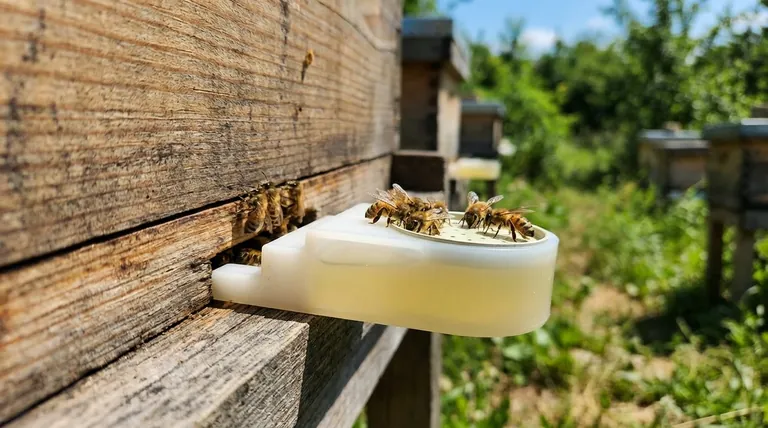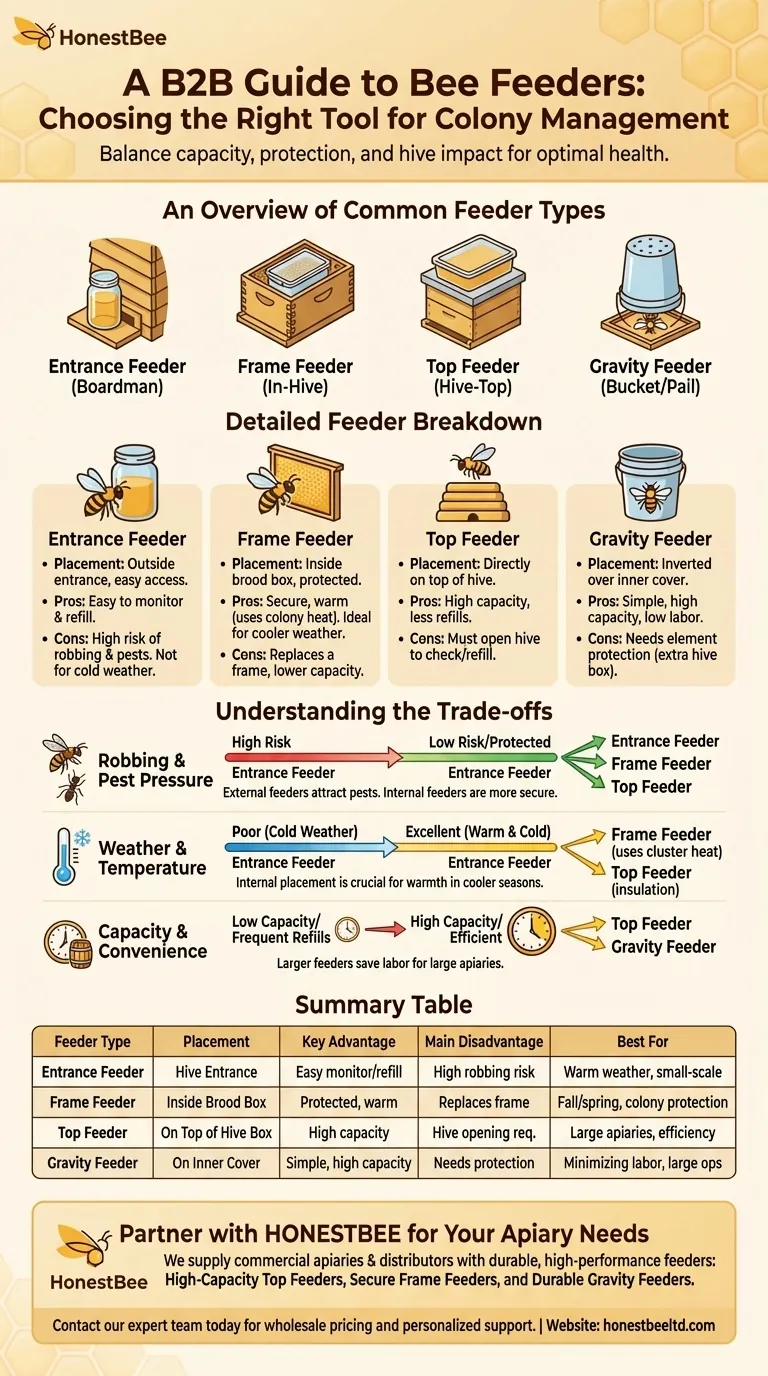When managing a honey bee colony, you have several effective feeding options. The most common types of bee feeders are entrance feeders, in-hive frame feeders, and high-capacity top feeders. Each is designed with a specific purpose, tailored to different hive configurations, weather conditions, and beekeeping goals.
The best bee feeder isn't about a single "best" model, but about choosing the right tool for the job. Your decision should balance the feeder's capacity, its impact on the hive, and its ability to protect the colony from pests and the elements.

An Overview of Common Feeder Types
Understanding the core design of each feeder is the first step. They differ primarily in their placement—at the entrance, inside the hive, or on top of it—which dictates their advantages and disadvantages.
Entrance Feeders (Boardman Feeders)
An entrance feeder is a simple device, typically a small glass jar or plastic container, that fits into the hive's entrance. The bees access the sugar syrup through small holes in the lid.
These feeders are very easy to monitor and refill without disturbing the colony, as the entire unit is outside the hive.
However, their external placement makes them highly susceptible to robbing by other bees and pests. They are also only suitable for warm weather, as the syrup will get cold quickly.
Frame Feeders (In-Hive Feeders)
A frame feeder is a plastic container built to the same dimensions as a standard hive frame. It hangs inside the brood box or super, replacing one of the wooden frames.
This internal placement is its greatest strength. It protects the syrup from robbers and keeps it warm from the cluster's heat, making it excellent for cooler weather.
Most modern frame feeders include built-in ladders or textured walls to help prevent bees from drowning, which was a significant issue with older designs.
Top Feeders (Hive-Top Feeders)
Top feeders are high-capacity containers that sit directly on top of the uppermost hive box, beneath the outer cover. They can hold a gallon or more of syrup.
Their large volume is ideal for feeding colonies quickly or for beekeepers who want to minimize the frequency of refills.
These feeders are well-protected from robbers, but they require you to open the hive to check levels and refill. They often have specific designs, like central access points, to keep bees from drowning in the large reservoir of syrup.
Gravity Feeders (Bucket or Pail Feeders)
A gravity feeder is typically a bucket or can with a screened or perforated lid. It is inverted over the hole in the hive's inner cover, creating a vacuum that dispenses syrup as the bees consume it.
This method is simple, offers high capacity, and significantly reduces the beekeeper's workload.
To be effective, a gravity feeder must be protected from the elements by placing an empty hive box around it before putting on the outer cover.
Understanding the Trade-offs
Choosing a feeder involves more than just picking a design you like. You must weigh the pros and cons based on your specific environment and management style.
Robbing and Pest Pressure
External feeders, especially entrance feeders, are a clear invitation to robber bees, wasps, and ants. They can create intense pressure on a weak colony.
Internal feeders, like frame and top feeders, almost eliminate the risk of robbing because the food source is located deep within the hive's defenses.
Weather and Temperature
In cooler climates or during the shoulder seasons of spring and fall, keeping syrup warm is critical.
Frame feeders excel here, as the syrup benefits directly from the colony's cluster heat. Top feeders also offer good insulation. Entrance feeders are a poor choice in cool temperatures.
Capacity and Convenience
For a beekeeper with many hives, efficiency is key. Top feeders and bucket feeders hold large amounts of syrup, drastically reducing the labor needed for refilling.
Conversely, entrance feeders are convenient for quick checks on a single hive, as you don't need to break the propolis seal to see if they need more food.
Making the Right Choice for Your Colony
Your decision should be guided by your colony's needs and your goals as a beekeeper.
- If your primary focus is simplicity for a small hive in warm weather: An entrance feeder is a straightforward and easy-to-monitor starting point.
- If your primary focus is protecting your colony from robbers or feeding in cooler weather: An in-hive frame feeder offers the best combination of safety and accessibility for the bees.
- If your primary focus is efficiency and minimizing labor for a large apiary: High-capacity top feeders or gravity-style bucket feeders are the most effective choice.
Choosing the right feeder is a foundational step in responsible hive management that directly supports the health and productivity of your bees.
Summary Table:
| Feeder Type | Placement | Key Advantage | Main Disadvantage | Best For |
|---|---|---|---|---|
| Entrance Feeder | Hive Entrance | Easy to monitor & refill | High risk of robbing & pests | Warm weather, small-scale beekeeping |
| Frame Feeder | Inside Brood Box | Protected from robbers, good for cool weather | Replaces a frame, lower capacity | Fall/spring feeding, colony protection |
| Top Feeder | On Top of Hive Box | High capacity, reduces refill frequency | Requires opening hive to check | Large apiaries, efficiency |
| Gravity Feeder | On Inner Cover | Simple, high capacity, low maintenance | Needs protection from elements | Minimizing labor, large-scale operations |
Ready to Optimize Your Apiary's Feeding Strategy?
Choosing the right bee feeder is crucial for your colony's health and productivity. HONESTBEE supplies commercial apiaries and beekeeping equipment distributors with the durable, high-performance feeders they need to succeed.
We offer a full range of wholesale beekeeping supplies and equipment, including:
- High-Capacity Top Feeders for efficient large-scale operations.
- Secure Frame Feeders to protect your investment from pests.
- Durable Gravity Feeders to minimize your labor costs.
Let us help you select the perfect feeding solution for your specific climate and management goals. Contact our expert team today for wholesale pricing and personalized support!
Visual Guide

Related Products
- Classic Boardman Entrance Bee Feeder Hive Front Feeding Solution
- HONESTBEE Entrance Bee Feeder Professional Hive Nutrition Solution for Beekeeping
- HONESTBEE Professional Entrance Bee Feeder Hive Nutrition Solution
- Boardman Entrance Bee Feeder Durable Galvanized Steel and Wood Construction for Beekeeping
- Professional In-Hive Frame Bee Feeder by HONESTBEE
People Also Ask
- Should bees be fed after installing a nucleus hive? Ensure Your New Colony Thrives
- What is the best feeder for bees? Choose the Right Feeder for Your Hive's Success
- What types of bee feeders are available for beginners? Start with the Simple Entrance Feeder
- How is the mesh ladder and barrier installed in the feeder box? A Step-by-Step Guide to Prevent Bee Drowning
- How to make an entrance feeder for bees? A DIY Guide for Safe & Effective Feeding



















